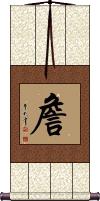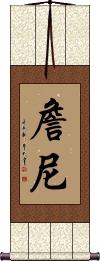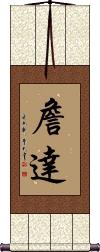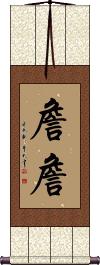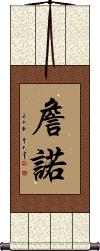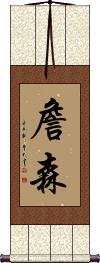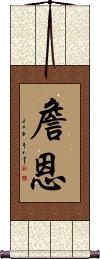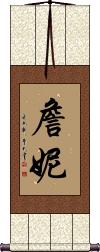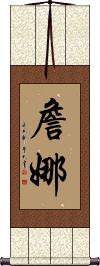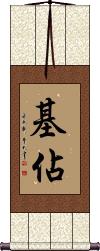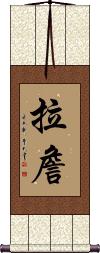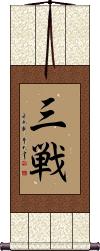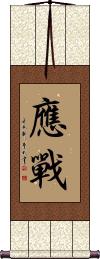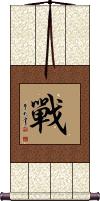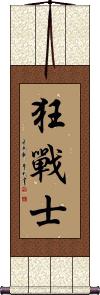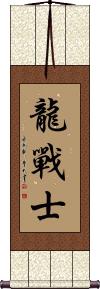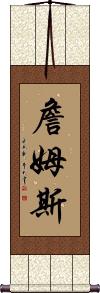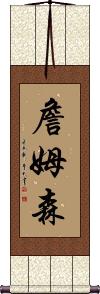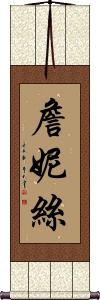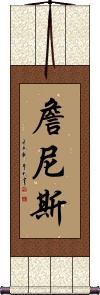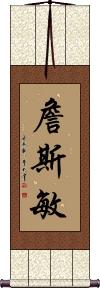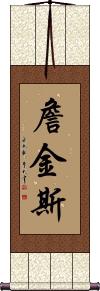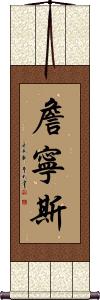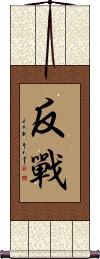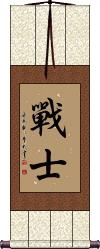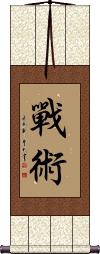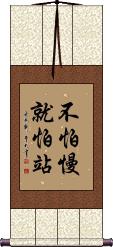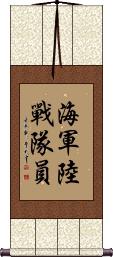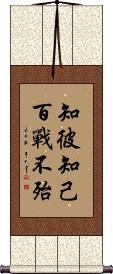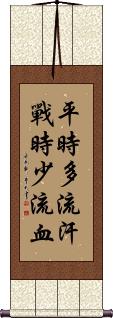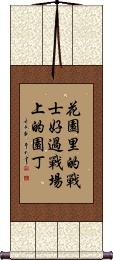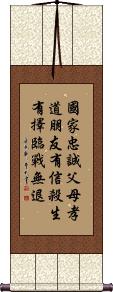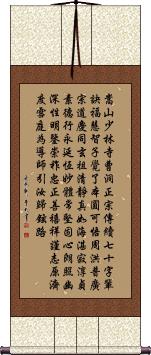Many custom options...
And formats...

Zhan in Chinese / Japanese...
Buy a Zhan calligraphy wall scroll here!
Personalize your custom “Zhan” project by clicking the button next to your favorite “Zhan” title below...
1. Chan
2. Jann
3. Gianni
4. Janda
5. Janey
6. Janjan
7. Janno
8. Jansen
9. Jenn
10. Jensen
11. Jhane
12. Jianna
13. Kizhan
14. Rajan
15. Rojan
16. Sanchin
18. War
19. Zhane
20. Sujen
21. Jenma
22. Jenne
23. Berserker
24. Dragon Warrior
25. Gianluca
26. James
27. Jameson
28. Janice
29. Janis
30. Jannett
31. Jasmine
32. Jenkins
33. Jennings
34. Jenniyah
35. Jentry
36. Janjum
38. Fighter
39. Tactics of War
40. Dragon Warrior
41. Ghost Warrior
42. Gianluigi
44. Inner Warrior
45. Priyanjan
46. Warrior Scholar
47. Wind Warrior
48. Battle of Chosin Reservoir
49. Marine Corps
50. Do not fear being slow, fear standing still
51. Marine
52. Know Your Enemy, Know Yourself, and You Cannot Lose
53. The More We Sweat in Training, The Less We Bleed in Battle
54. It is better to be a warrior in a garden than a gardener in a war
Chan
Taiwanese Surname
This is a surname that romanizes as Chan from the Taiwanese (Wade-Giles) method or romanizing Mandarin Chinese.
The actual meaning is excellent or verbose.
Jann
Gianni
Janda
Janey
Janjan
Janno
Jansen
Jenn
Jensen
Jhane
Jianna
Kizhan
Rajan
Rojan
Sanchin
三戦 is a title that literally means “three battles/conflicts/wars.”
三戦 is often figuratively used to relay the idea of a battle to unify the mind, body, and spirit.
Original usage likely comes from Fujian province in Southern China (just across from Taiwan).
This title is used in various schools such as Okinawan Karate, Uechi-Ryū, Gōjū-Ryū, Fujian White Crane, and Five Ancestors among others.
Take Up a Challenge
應戰 is a Chinese word that means “to take up a challenge” or “to face an attack and meet it.”
戰 means war, battle, or fight.
戰 is often used to title various wars. For instance, if you add the character for “2” before this character, you have the Chinese title for WWII.
In certain contexts, someone can use this word to mean campaign, game, or match.
Written as 戦 in modern Japanese.
![]() Note: In Japan, they tend to use the form shown to the right. If you pick the Japanese master calligrapher, you may get/request this version. It should also be noted that this Kanji is seldom used alone in Japanese.
Note: In Japan, they tend to use the form shown to the right. If you pick the Japanese master calligrapher, you may get/request this version. It should also be noted that this Kanji is seldom used alone in Japanese.
Zhane
Sujen
Jenma
Jenne
Berserker
Dragon Warrior
Gianluca
James
Jameson
Janice
Janis
Jannett
Jasmine
Jenkins
Jennings
Jenniyah
Jentry
Janjum
Antiwar / Anti-War
反戰 means antiwar, as in what a pacifist believes in.
China does plenty of saber-rattling but thankfully doesn't go to war very often, and Japan has embraced a pacifist ideology. Therefore, it's rare to need this word. However, this is the kind of word that war protesters would write on their signs.
![]() There is a modern Japanese version of the second character which has become the standard in Japan after WWII. If you want your calligraphy written in the modern Japanese form, please click on the Kanji shown to the right instead of the button above. Note: Most Japanese and all Chinese people will recognize the form shown in the upper left.
There is a modern Japanese version of the second character which has become the standard in Japan after WWII. If you want your calligraphy written in the modern Japanese form, please click on the Kanji shown to the right instead of the button above. Note: Most Japanese and all Chinese people will recognize the form shown in the upper left.
Fighter
Warrior / Soldier
戰士 is how to write “fighter” in Chinese, ancient Japanese Kanji, and old Korean Hanja.
The first character means war, warfare, or battle.
The second character means soldier, officer, man, or pawn.
戰士 can also mean soldier or warrior. Usually this will be read as “fighter” or “one who fights.” 戰士 is an odd selection for a wall scroll unless you are a boxer, ultimate fighter, or otherwise participate in combat sports.
Other translations include combatant or champion.
![]() Note that after WWII, the first Kanji was reformed/simplified. This modern Japanese version is shown to the right. If you want this version, click on the Kanji to the right, instead of the button above.
Note that after WWII, the first Kanji was reformed/simplified. This modern Japanese version is shown to the right. If you want this version, click on the Kanji to the right, instead of the button above.
Tactics of War
戰術 can mean “tactics of war,” “battle tactics” or simply “tactics” (being that warfare is implied in that English word).
This word is written in the ancient and traditional form of Chinese, Japanese, and Korean.
![]()
In modern Japan, the first character has been simplified or modified. If you want the modern Japanese Kanji version, just click on that character shown to the right.
Dragon Warrior
Ghost Warrior
Gianluigi
Heart of a Warrior
Inner Warrior
Priyanjan
Warrior Scholar
Wind Warrior
Battle of Chosin Reservoir
Marine Corps
海軍陸戰隊 is the Chinese way to express “Marine Corps.” This could be the Marine Corps of virtually any country that has an amphibious military force.
Let me know if you want a more specific title, such as British Royal Marines or U.S. Marine Corps.
The Chinese title for Marines is very verbose...
Breaking down each character this means:
“ocean/sea military/arms shore/land fighting/war/battle corps/team/group.”
See Also: Military
Do not fear being slow, fear standing still
Marine
Amphibious Warrior
海軍陸戰隊員 is the Chinese way to express “Marine.” (as in a member of the Marine Corps). It is not country-specific, so it could be the Royal Marines, U.S. Marines, Chinese Marines, etc.
In Australian English, they would translate this as “Naval Infantryman.”
Breaking down each character this means:
“ocean/sea military/arms shore/land fighting/war/battle corps/team/group person/member.” Note that the first two characters are presented together but outside of this phrase mean “navy” (sea military).
See Also: Warrior | Military | Navy | Art of War
Know Your Enemy, Know Yourself, and You Cannot Lose
知彼知己百戰不殆 is from Sun Tzu's (Sunzi's) Art of War. It means that if you know and understand the enemy, you also know yourself, and thus with this complete understanding, you cannot lose.
This proverb is often somewhat directly translated as “Know the enemy and know yourself, and you can fight a hundred battles without defeat.”
It can also be translated as “If you know both yourself and your enemy, you can come out of hundreds of battles without danger,” or “Know your enemy, know yourself, and your victory will not be threatened.”
The More We Sweat in Training, The Less We Bleed in Battle
There is more than one way to translate the ancient Chinese military proverb, 平时多流汗战时少流血. Here are a few interpretations:
A drop of sweat spent in a drill is a drop of blood saved in war.
More practice will give one a better chance of success in real situations.
The more you sweat in training, the less you bleed in battle.
I heard this many times when I was a U.S. Marine but I had no idea at the time that it was actually an old Chinese proverb.
See Also: Blood Sweat and Tears
It is better to be a warrior in a garden than a gardener in a war
花園里的戰士好過戰場上的園丁 is the Chinese for the phrase, “It is better to be a warrior in a garden than a gardener in a war.”
This proverb is purported to come from the following exchange:
A student approaches his samurai master and says,
“Teacher, you instruct me how to fight, yet you preach to me about peace. How do I reconcile the two?”
The samurai responds,
“Because it is better to be a warrior in a garden than a gardener in a war.”
Five Codes of Tang Soo Do
国家忠诚父母孝道朋友有信杀生有择临战无退 are the five codes of Tang Soo Do.
I suggest you have this arranged in five columns when you get to the options page for your custom calligraphy wall scroll.
Here are my translations of each of the five codes:
國家忠誠 Be loyal to your country.
父母孝道 In regards to parents, behave in a filial way.
朋友有信 Be faithful in friendship.
殺生有擇 When fighting for life and death, make noble choices.
臨戰無退 No retreat in battle.
Note: “Tang Soo Do” is a romanization of 唐手道. It's 당수도 in Korean Hangul. It can also be romanized as “Tangsudo” or “Dangsudo.”
Shaolin Generational Poem
This is a poem, including a title, that celebrates the tactics and virtues of the Shaolin Kung Fu Monks for future generations.
Not the results for zhan that you were looking for?
Below are some entries from our dictionary that may match your zhan search...
| Characters If shown, 2nd row is Simp. Chinese |
Pronunciation Romanization |
Simple Dictionary Definition |
詹 see styles |
zhān zhan1 chan |
More info & calligraphy: Jann |
反戰 反战 see styles |
fǎn zhàn fan3 zhan4 fan chan |
More info & calligraphy: Antiwar / Anti-War |
應戰 应战 see styles |
yìng zhàn ying4 zhan4 ying chan |
More info & calligraphy: Take Up a Challenge |
戰士 战士 see styles |
zhàn shì zhan4 shi4 chan shih |
More info & calligraphy: Fighter |
詹森 see styles |
zhān sēn zhan1 sen1 chan sen |
More info & calligraphy: Jensen |
狂戰士 狂战士 see styles |
kuáng zhàn shì kuang2 zhan4 shi4 k`uang chan shih kuang chan shih |
More info & calligraphy: Berserker |
詹姆斯 see styles |
zhān mǔ sī zhan1 mu3 si1 chan mu ssu |
More info & calligraphy: James |
佔 占 see styles |
zhàn zhan4 chan |
variant of 占[zhan4] See: 占 |
偡 see styles |
zhàn zhan4 chan |
(literary) orderly; neat |
占 see styles |
zhàn zhan4 chan uranai うら |
to take possession of; to occupy; to take up (archaism) fortune-telling; divination To divine, prognosticate. |
呫 see styles |
zhān zhan1 chan |
to drink; to sip; to taste; to lick; whisper; petty |
展 see styles |
zhǎn zhan3 chan hiromu ひろむ |
to spread out; to open up; to exhibit; to put into effect; to postpone; to prolong; exhibition (suffix) (abbreviation) (See 展示) exhibition; exhibit; (personal name) Hiromu To extend, expand, stretch. |
嶃 崭 see styles |
zhǎn zhan3 chan |
variant of 嶄|崭[zhan3] |
嶄 崭 see styles |
zhǎn zhan3 chan |
towering; prominent; very; extremely; (dialect) marvelous; excellent |
戦 see styles |
zhàn zhan4 chan sen せん |
Japanese variant of 戰|战 (suffix) (1) war; battle; (suffix) (2) match; game; competition; (surname) Sen |
戰 战 see styles |
zhàn zhan4 chan sen |
to fight; fight; war; battle War, hostilities, battle; alarm, anxiety, terrified; translit. can. |
搌 see styles |
zhǎn zhan3 chan |
to sop up; to dab |
斬 斩 see styles |
zhǎn zhan3 chan kiri きり |
to behead (as form of capital punishment); to chop (rare) beheading; decapitation; (personal name) Kiri |
旃 see styles |
zhān zhan1 chan sen |
felt; silken banner A flag on a bent pole; to warn; translit. generally can, rarely śan, ṣan, cin, kim. |
栴 see styles |
zhān zhan1 chan sen せん |
used in 栴檀[zhan1 tan2] (surname) Sen |
桟 see styles |
zhàn zhan4 chan kakehashi かけはし |
Japanese variant of 棧|栈[zhan4] (1) frame (i.e. of a sliding door); (2) crosspiece; bar; (3) (See 猿・4) sliding wooden bolt (for holding a door or window shut); (4) rung (of a ladder); (surname) Kakehashi |
棧 栈 see styles |
zhàn zhan4 chan kakebashi かけばし |
a wooden or bamboo pen for sheep or cattle; wood or bamboo trestlework; a warehouse; (computing) stack (surname) Kakebashi |
樿 椫 see styles |
zhǎn zhan3 chan |
(wood) |
氈 毡 see styles |
zhān zhan1 chan kamo; sen かも; せん |
felt (fabric) (See 毛氈・もうせん) carpet; rug (esp. felt) |
氊 毡 see styles |
zhān zhan1 chan |
variant of 氈|毡[zhan1] |
沾 see styles |
zhān zhan1 chan |
to moisten; to be infected by; to receive benefit or advantage through a contact; to touch |
湛 see styles |
zhàn zhan4 chan yasushi やすし |
deep; clear (water) (given name) Yasushi Deep, clear, placid, to soak. |
琖 see styles |
zhǎn zhan3 chan |
wine cup |
盞 盏 see styles |
zhǎn zhan3 chan sakazuki さかづき uki さかずき |
a small cup; classifier for lamps sake cup; cup for alcoholic beverages |
瞻 see styles |
zhān zhan1 chan sen |
to gaze; to view To look up to, or for; revere, adore, expect, i.e. 瞻仰; translit. ca, ja. |
Click here for more zhan results from our dictionary
The following table may be helpful for those studying Chinese or Japanese...
| Title | Characters | Romaji (Romanized Japanese) | Various forms of Romanized Chinese | |
| Chan | 詹 | zhān / zhan1 / zhan | chan | |
| Jann | 詹 | zhān / zhan1 / zhan | chan | |
| Gianni | 詹尼 | zhān ní / zhan1 ni1 / zhan ni / zhanni | chan ni / channi | |
| Janda | 詹達 詹达 | zhān dá / zhan1 da2 / zhan da / zhanda | chan ta / chanta | |
| Janey | 詹尼 | zhān ní / zhan1 ni1 / zhan ni / zhanni | chan ni / channi | |
| Janjan | 詹詹 | zhān zhān zhan1 zhan1 zhan zhan zhanzhan | chan chan chanchan |
|
| Janno | 詹諾 詹诺 | zhān nuò / zhan1 nuo4 / zhan nuo / zhannuo | chan no / channo | |
| Jansen | 詹森 | zhān sēn / zhan1 sen1 / zhan sen / zhansen | chan sen / chansen | |
| Jenn | 詹恩 | zhān ēn / zhan1 en1 / zhan en / zhanen | chan en / chanen | |
| Jensen | 詹森 | zhān sēn / zhan1 sen1 / zhan sen / zhansen | chan sen / chansen | |
| Jhane | 詹妮 | zhān nī / zhan1 ni1 / zhan ni / zhanni | chan ni / channi | |
| Jianna | 詹娜 | zhān nà / zhan1 na4 / zhan na / zhanna | chan na / channa | |
| Kizhan | 基佔 基占 | jī zhàn / ji1 zhan4 / ji zhan / jizhan | chi chan / chichan | |
| Rajan | 拉詹 | lā zhān / la1 zhan1 / la zhan / lazhan | la chan / lachan | |
| Rojan | 羅詹 罗詹 | luó zhān / luo2 zhan1 / luo zhan / luozhan | lo chan / lochan | |
| Sanchin | 三戦 | san sen / sansen | sān zhàn / san1 zhan4 / san zhan / sanzhan | san chan / sanchan |
| Take Up a Challenge | 應戰 应战 | yìng zhàn ying4 zhan4 ying zhan yingzhan | ying chan yingchan |
|
| War | 戰 / 戦 战 | sen | zhàn / zhan4 / zhan | chan |
| Zhane | 詹恩 | zhān ēn / zhan1 en1 / zhan en / zhanen | chan en / chanen | |
| Sujen | 蘇詹 苏詹 | sū zhān / su1 zhan1 / su zhan / suzhan | su chan / suchan | |
| Jenma | 詹馬 詹马 | zhān mǎ / zhan1 ma3 / zhan ma / zhanma | chan ma / chanma | |
| Jenne | 詹尼 | zhān ní / zhan1 ni2 / zhan ni / zhanni | chan ni / channi | |
| Berserker | 狂戰士 | kuáng zhàn shì kuang2 zhan4 shi4 kuang zhan shi kuangzhanshi | k`uang chan shih kuangchanshih kuang chan shih |
|
| Dragon Warrior | 龍戰士 龙战士 | lóng zhàn shì long2 zhan4 shi4 long zhan shi longzhanshi | lung chan shih lungchanshih |
|
| Gianluca | 詹盧卡 詹卢卡 | zhān lú kǎ zhan1 lu2 ka3 zhan lu ka zhanluka | chan lu k`a chanluka chan lu ka |
|
| James | 詹姆斯 | zhān mǔ sī zhan1 mu3 si1 zhan mu si zhanmusi | chan mu ssu chanmussu |
|
| Jameson | 詹姆森 | zhān mǔ sēn zhan1 mu3 sen1 zhan mu sen zhanmusen | chan mu sen chanmusen |
|
| Janice | 詹妮絲 詹妮丝 | zhān nī sī zhan1 ni1 si1 zhan ni si zhannisi | chan ni ssu channissu |
|
| Janis | 詹尼斯 | zhān ní sī zhan1 ni1 si1 zhan ni si zhannisi | chan ni ssu channissu |
|
| Jannett | 詹尼特 | zhān ní tè zhan1 ni2 te4 zhan ni te zhannite | chan ni t`e channite chan ni te |
|
| Jasmine | 詹斯敏 | zhān sī mǐn zhan1 si1 min3 zhan si min zhansimin | chan ssu min chanssumin |
|
| Jenkins | 詹金斯 | zhān jīn sī zhan1 jin1 si1 zhan jin si zhanjinsi | chan chin ssu chanchinssu |
|
| Jennings | 詹寧斯 詹宁斯 | zhān níng sī zhan1 ning2 si1 zhan ning si zhanningsi | chan ning ssu channingssu |
|
| Jenniyah | 詹妮雅 | zhān nī yǎ zhan1 ni1 ya3 zhan ni ya zhanniya | chan ni ya channiya |
|
| Jentry | 詹特里 | zhān tè lǐ zhan1 te4 li3 zhan te li zhanteli | chan t`e li chanteli chan te li |
|
| Janjum | 詹朱姆 | zhān zhū mǔ zhan1 zhu1 mu3 zhan zhu mu zhanzhumu | chan chu mu chanchumu |
|
| Antiwar Anti-War | 反戰 反战 / 反戦 | han sen / hansen | fǎn zhàn / fan3 zhan4 / fan zhan / fanzhan | fan chan / fanchan |
| Fighter | 戰士 战士 / 戦士 | sen shi / senshi | zhàn shì / zhan4 shi4 / zhan shi / zhanshi | chan shih / chanshih |
| Tactics of War | 戰術 / 戦術 战术 | senjutsu | zhàn shù / zhan4 shu4 / zhan shu / zhanshu | chan shu / chanshu |
| Dragon Warrior | 斗龍戰士 斗龙战士 | dòu lóng zhàn shì dou4 long2 zhan4 shi4 dou long zhan shi doulongzhanshi | tou lung chan shih toulungchanshih |
|
| Ghost Warrior | 幽靈戰士 幽灵战士 | yōu líng zhàn shì you1 ling2 zhan4 shi4 you ling zhan shi youlingzhanshi | yu ling chan shih yulingchanshih |
|
| Gianluigi | 詹路易吉 | zhān lù yì jí zhan1 lu4 yi4 ji2 zhan lu yi ji zhanluyiji | chan lu i chi chanluichi |
|
| Heart of a Warrior | 戰士之心 战士之心 | zhàn shì zhī xīn zhan4 shi4 zhi1 xin1 zhan shi zhi xin zhanshizhixin | chan shih chih hsin chanshihchihhsin |
|
| Inner Warrior | 內心戰士 内心战士 | nèi xīn zhàn shì nei4 xin1 zhan4 shi4 nei xin zhan shi neixinzhanshi | nei hsin chan shih neihsinchanshih |
|
| Priyanjan | 普里揚詹 普里扬詹 | pǔ lǐ yáng zhān pu3 li3 yang2 zhan1 pu li yang zhan puliyangzhan | p`u li yang chan puliyangchan pu li yang chan |
|
| Warrior Scholar | 戰士學者 战士学者 | zhàn shì xué zhě zhan4 shi4 xue2 zhe3 zhan shi xue zhe zhanshixuezhe | chan shih hsüeh che chanshihhsüehche |
|
| Wind Warrior | 風中戰士 风中战士 | fēng zhōng zhàn shì feng1 zhong1 zhan4 shi4 feng zhong zhan shi fengzhongzhanshi | feng chung chan shih fengchungchanshih |
|
| Battle of Chosin Reservoir | 長津湖戰役 长津湖战役 | cháng jīn hú zhàn yì chang2 jin1 hu2 zhan4 yi4 chang jin hu zhan yi changjinhuzhanyi | ch`ang chin hu chan i changchinhuchani chang chin hu chan i |
|
| Marine Corps | 海軍陸戰隊 海军陆战队 | hǎi jūn lù zhàn duì hai3 jun1 lu4 zhan4 dui4 hai jun lu zhan dui haijunluzhandui | hai chün lu chan tui haichünluchantui |
|
| Do not fear being slow, fear standing still | 不怕慢就怕站 | bú pà màn jiù pà zhàn bu2 pa4 man4 jiu4 pa4 zhan4 bu pa man jiu pa zhan bupamanjiupazhan | pu p`a man chiu p`a chan pupamanchiupachan pu pa man chiu pa chan |
|
| Marine | 海軍陸戰隊員 海军陆战队员 | hǎi jūn lù zhàn duì yuán hai3 jun1 lu4 zhan4 dui4 yuan2 hai jun lu zhan dui yuan haijunluzhanduiyuan | hai chün lu chan tui yüan haichünluchantuiyüan |
|
| Know Your Enemy, Know Yourself, and You Cannot Lose | 知彼知己百戰不殆 知彼知己百战不殆 | zhí bǐ zhí jī bǎi zhàn bú dài zhi2 bi3 zhi2 ji1 bai3 zhan4 bu2 dai4 zhi bi zhi ji bai zhan bu dai zhibizhijibaizhanbudai | chih pi chih chi pai chan pu tai | |
| The More We Sweat in Training, The Less We Bleed in Battle | 平時多流汗戰時少流血 平时多流汗战时少流血 | píng shí duō liú hàn zhàn shí shǎo liú xuè ping2 shi2 duo1 liu2 han4 zhan4 shi2 shao3 liu2 xue4 ping shi duo liu han zhan shi shao liu xue | p`ing shih to liu shih shao liu hsüeh ping shih to liu shih shao liu hsüeh |
|
| It is better to be a warrior in a garden than a gardener in a war | 花園里的戰士好過戰場上的園丁 花园里的战士好过战场上的园丁 | huā yuán lǐ de zhàn shì hǎo guò zhàn chǎng shàng de yuán dīng huā yuán lǐ de zhàn shì hǎo guò zhàn chǎng shàng de yuán dīng ài wēng huā yuán lǐ de zhàn shì hǎo guò zhàn chǎng shàng de yuán dīng hua1 yuan2 li3 de zhan4 shi4 hao3 guo4 zhan4 chang3 shang4 de yuan2 ding1 hua1 yuan2 li3 de zhan4 shi4 hao3 guo4 zhan4 chang3 shang4 de yuan2 ding1 ai4 weng1 hua1 yuan2 li3 de zhan4 shi4 hao3 guo4 zhan4 chang3 shang4 de yuan2 ding1 hua yuan li de zhan shi hao guo zhan chang shang de yuan ding hua yuan li de zhan shi hao guo zhan chang shang de yuan ding ai weng hua yuan li de zhan shi hao guo zhan chang shang de yuan ding | hua yüan li te chan shih hao kuo chan ch`ang shang te yüan ting hua yüan li te chan shih hao kuo chan ch`ang shang te yüan ting ai weng hua yüan li te chan shih hao kuo chan ch`ang shang te yüan ting hua yüan li te chan shih hao kuo chan chang shang te yüan ting hua yüan li te chan shih hao kuo chan chang shang te yüan ting ai weng hua yüan li te chan shih hao kuo chan chang shang te yüan ting |
|
| Five Codes of Tang Soo Do | 國家忠誠父母孝道朋友有信殺生有擇臨戰無退 国家忠诚父母孝道朋友有信杀生有择临战无退 | guó jiā zhōng chéng fù mǔ xiào dào péng yǒu yǒu xìn shā shēng yǒu zé lín zhàn wú tuì guo2 jia1 zhong1 cheng2 fu4 mu3 xiao4 dao4 peng2 you3 you3 xin4 sha1 sheng1 you3 ze2 lin2 zhan4 wu2 tui4 guo jia zhong cheng fu mu xiao dao peng you you xin sha sheng you ze lin zhan wu tui | kuo chia chung ch`eng fu mu hsiao tao p`eng yu yu hsin sha sheng yu tse lin chan wu t`ui kuo chia chung cheng fu mu hsiao tao peng yu yu hsin sha sheng yu tse lin chan wu tui |
|
| Shaolin Generational Poem | 嵩山少林寺曹洞正宗傳續七十字輩訣福慧智子覺了本圓可悟周洪普廣宗道慶同玄祖清靜真如海湛寂淳貞素德行永延恆妙體常堅固心朗照幽深性明鑒崇祚忠正善禧祥謹志原濟度雪庭為導師引汝歸鉉路 嵩山少林寺曹洞正宗传续七十字辈诀福慧智子觉了本圆可悟周洪普广宗道庆同玄祖清静真如海湛寂淳贞素德行永延恒妙体常坚固心朗照幽深性明鉴崇祚忠正善禧祥谨志原济度雪庭为导师引汝归铉路 | sōng shān shào lín sì cáo dòng zhèng zōng chuán xù qī shí zì bèi jué fú huì zhì zǐ jiào le běn yuán kě wù zhōu hóng pǔ guǎng zōng dào qìng tóng xuán zǔ qīng jìng zhēn rú hǎi zhàn jì chún zhēn sù dé xíng yong song1 shan1 shao4 lin2 si4 cao2 dong4 zheng4 zong1 chuan2 xu4 qi1 shi2 zi4 bei4 jue2 fu2 hui4 zhi4 zi3 jiao4 le5 ben3 yuan2 ke3 wu4 zhou1 hong2 pu3 guang3 zong1 dao4 qing4 tong2 xuan2 zu3 qing1 jing4 zhen1 ru2 hai3 zhan4 ji4 chun2 zhen1 su4 de2 xing2 yong song shan shao lin si cao dong zheng zong chuan xu qi shi zi bei jue fu hui zhi zi jiao le ben yuan ke wu zhou hong pu guang zong dao qing tong xuan zu qing jing zhen ru hai zhan ji chun zhen su de xing yong | sung shan shao lin ssu ts`ao tung cheng tsung ch`uan hsü ch`i shih tzu pei chüeh fu hui chih tzu chiao le pen yüan k`o wu chou hung p`u kuang tsung tao ch`ing t`ung hsüan tsu ch`ing ching chen ju hai chan chi ch`un chen su te hsing yung sung shan shao lin ssu tsao tung cheng tsung chuan hsü chi shih tzu pei chüeh fu hui chih tzu chiao le pen yüan ko wu chou hung pu kuang tsung tao ching tung hsüan tsu ching ching chen ju hai chan chi chun chen su te hsing yung |
|
| In some entries above you will see that characters have different versions above and below a line. In these cases, the characters above the line are Traditional Chinese, while the ones below are Simplified Chinese. | ||||
Successful Chinese Character and Japanese Kanji calligraphy searches within the last few hours...
